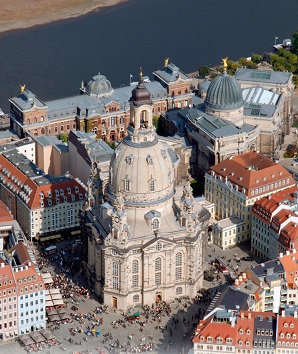
Church of Our Lady - a symbol of Dresden with a troubled history
 |
Although the bombs did not directly hit the temple in 1945, the sandstone from which the church was built could not withstand the high temperatures of around 1200 degrees Celsius generated by the firestorm raging throughout the city center. Thus, the church's dome collapsed. The famous temple found itself in ruins just like the vast majority of Dresden, which is referred to for its architectural beauty as the "Florence on the Elbe."
After the war, the building was located in the Russian zone, later in the German Democratic Republic under Moscow's control. The then-communist government decided not to reconstruct the dome, allowing its ruins to remind future generations of the horrors of World War II. The ruins of the temple therefore shaped the panorama of Dresden for another 45 years. However, all original stones were numbered and preserved shortly after the war, which facilitated the later reconstruction of the church.
Alongside the dissolution of communist power at the end of the 1980s, talk began about a possible reconstruction of the destroyed temple. In 1989, the Society for the Reconstruction of the Frauenkirche was established. It began in 1994 with sorting, documenting, and restoring 22,000 cubic meters of rubble, where each stone was cataloged for later use in the reconstruction. The original construction plans from the 18th century were not preserved, so restorers relied on old paintings and photographs, as well as documentation from repairs carried out on the church in the 1920s.
The actual reconstruction began in 1995, 50 years after the destruction. The architects modified the underground spaces from the original plans, creating a concert hall. All load-bearing pillars were built from sandstone. A new dome, weighing 12,000 tons, was created by gradually assembling precisely crafted stone pieces on a supporting wooden skeleton, which was eventually removed.
The reconstruction cost 180 million euros, over half of which was covered by a Dresden bank using funding certificates and a personal contribution of seven million euros. An additional 2.3 million euros came from the symbolic sale of building stones. Nearly one hundred million euros (around 2.52 billion CZK) were raised from a public collection, which was contributed to by nearly 600,000 people. The restored church was consecrated on October 30, 2005. Due to its poignant history, the Church of Our Lady has become a global symbol of tolerance, "a work of reconciliation and remembrance of peace," as described by the Saxon bishop Jochen Bohl during its ceremonial reopening.
Frauenkirche has a rich history. The first church building, which stood in the 11th century on the site of today's baroque temple, was dedicated to the Virgin Mary. It served missionaries bringing Christianity to the surrounding Serbian villages. At the beginning of the 13th century, after the founding of Dresden, it became the city parish church, where all important church ceremonies, including baptisms, weddings, and funerals, took place. As the fame of Dresden grew, meanwhile the residence of the Saxon electors, the church's capacity became insufficient. It was expanded and rebuilt several times. However, it retained its name even after the Reformation, when it was handed over to the Protestant church, which does not worship Mariology. Its modern form was achieved between 1726 and 1743. During this time, the famous dome, known as the stone bell, was created, mostly under the supervision of the builder George Bähr, and it posed a true construction challenge.
The English translation is powered by AI tool. Switch to Czech to view the original text source.
0 comments
add comment











